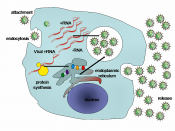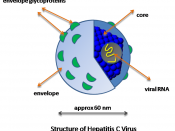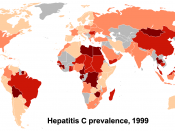SPECIFIC PURPOSE: To inform the audience about Hepatitis C.
INTRODUCTION: I. Let me start off by telling you a story about a 50 yr old man; who had always been healthy and very active. Recently, this man started to have muscle aches, severe fatigue, and headaches. He didn't think anything of it and just figured it was just the flu since it was the flu season. Then during his annual check up, or as some like to call it "Their oil change or tune up," this man's physician decided that he should go ahead and draw a series of blood tests. A week later this man receives a call from his doctor's office. That's when he receives the news that he has the disease called "Hepatitis C." II. There are many stories about people such as this one of people that don't have the knowledge nor do they have an idea of this "Silent Killer" known as Hepatitis C.
III. That is why it's very important to be informed on this very lethal disease.
(Transitional Sentence: In order to be well informed on Hepatitis C, one first needs to know "what is Hepatitis C.") BODY: I. Description of Hepatitis C: A. What is Hepatitis C? 1. Hepatitis C is a blood-borne virus that was previously referred to as non-A/non-B hepatitis; which enters the body through direct blood exposure.
a. Items such as syringes, tattoos, body piercing, razors, nail files, and earrings contribute in the transmission of HCV.
b. There are six major genotypes; genotype 1 being the most common in the U.S.
c. Before 1992, many people contacted HCV through blood transfusion.
2. HCV is a serious viral infection that can lead to permanent liver liver damage, including cirrhosis, liver failure, and liver cancer by attacking the cells in the liver.
B. What is Cirrhosis and when does it occur? 1. Cirrhosis is the process in which the liver cells are damaged or killed and are replaced with scar tissue; usually occurring with Chronic HCV.
2. In severe cases of cirrhosis, a person may require to have a liver transplant.
(Transitional Sentence: Now that you have some knowledge of what HCV is, next I need to inform you on what signs to look for.) II. There are symptoms and stages that are associated with HCV.
A. The first state of HCV, is the acute stage; which usually resolves after 12 weeks.
1. Many people have reported few or no symptoms during this stage.
2. Symptoms that have been reported are flu-like illnesses, fatigue, fever, night sweats, nausea, vomiting and abdominal pain.
B. The next stage is Chronic HCV; in which progresses over the course of 10-40 years.
1. Many people with Chronic HCV also don't have any symptoms and live normal lives.
2. Other people experience flu-like symptoms including nausea, vomiting, fatigue, fever, and jaundice (yellowing of the skin and whites of the eyes.) (Transitional Sentence: Now that you know what the symptoms are; there are some treatments available.) III. Currently there are 3 FDA approved medications being used in monotherapy and combination therapy.
A. Until 1998, interferon alone (monotherapy) was the only approved treatment for HCV.
1. Interferon by injection is genetically engineered product based on a set of natural immune system proteins found in the body.
2. The standard protocol for interferon administration is to be injected 3 times per week for at least 1 year.
3. It is estimated that only 10-20% of individuals treated with interferon alone are able to permanently clear the virus.
B. Today pegylated interferon plus ribaviron in combination therapy has become the standard treatment.
1. Pegylated interferons are long-lasting interferons that are injected 3 times a week.
2. Ribavirin is an oral antiviral medication in which 800-1,200 mg are taken daily orally.
3. The treatment effectiveness is 28% for genotype 1, and 66% for genotype 2 and 3.
CONCLUSION: I. Hepatitis C is very a deadly disease that must not be underestimated.
A. It's good to be informed on what Hepatitis C is.
B. Know what the symptoms are.
C. Know that there are treatment available.
II. You must keep in mind that Hepatitis C kills 8,000-10,000 Americans a year and that there are over 4 million Americans infected with HCV; It is better to be informed now than never.
BIBLIOGRAPHY: Web site: American Liver Foundation at www.liverfoundatin.org Franciscus, Alan. A Guide to Understanding Hepatitis C, August 2003 p. 1-24: Hepatitis C Support Project.
Web site: Hepatitis C Connection at www.hepc-connection.org





